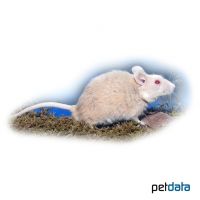Natal Multimammate Mouse (Mastomys natalensis)
| Natal Multimammate Mouse Mastomys natalensis | |
|---|---|
| Name | Natal Multimammate Mouse |
| Name Lat. | Mastomys natalensis |
| Family | Murids |
| Family lat. | Muridae |
| Order | Rodents |
| Order lat. | Rodentia |
| Origin | Southern Africa |
| Climate | Subtropical - tropical |
| Habitat | Savanna, scrubs |
| Diet | Seeds, plant matter, insects |
| Behavior | Nocturnal; ♂ territorial |
| Keeping | Pair, harem |
| Care Level | Moderate |
| Life Span | 1-2 years |
| Protection | No |
| Metric Units | |
| Size | 9-15 cm |
| Temperature | 20-24 °C |
| Housing | A: 0.5 m² / H: 50-60 cm |
| US Units | |
| Size | 3.5"-5.9" |
| Temperature | 68-75 °F |
| Housing | 5 ft² / 20" hight |
Distribution and habitat
Originally from South Africa, the nocturnal Natal meadow voles are widespread throughout sub-Saharan Africa. They live in self-dug burrows in the wet and dry savannahs and as adaptable crop followers in fields and gardens. As a breeding form they exist in different color variants (albino, piebald, etc.).
Maintenance
Minimum dimensions for the enclosure:
| 1-2 animals | area: 0,5 m² | height: 50-60 cm |
| Each additional animal | Area: + 20 |
A terrarium placed in a bright (no direct sunlight), draught-free and quiet place is recommended, with ventilation openings on the sides, and it must not be tightly closed at the top. The enclosure should be structured with stones, roots and branches, and provide hiding and shelter opportunities (rodent houses, platforms, cork tubes, clay caves, hollowed coconuts, etc.). You will need food and drinking containers, a sand bath (chinchilla sand) for grooming, nesting material (hay, grass) and a diggable substrate of commercial small animal litter or a peat and sand mixture covered with some bark mulch and dry leaves. The bedding depth should be 10 cm. Nail material, such as untreated twigs and branches of fruit trees, and a rodent stone must be available to wear down their teeth.
| temperature day: 20-24 °C | temperature night: 15-20 °C |
A natural day-night rhythm must be ensured.
Diet
Their diet is mainly vegetarian, with a preference for animal protein. The species-specific diet consists of a low-fat seed-grain mixture, available in specialty stores as dwarf hamster food and gerbil food (mix the two!), as well as cob millet as supplementary food, which also serves to keep them busy, supplemented with animal protein (curd, hard-boiled egg, insects, etc.), some fresh food (e.g., wild herbs, carrots, fruit) and a mineral stone. They drink very little. Better than a nipple waterer is a sturdy, open container. Water and food containers should be arranged so that they cannot become contaminated. Drinking water and food should be offered fresh daily.
A varied diet promotes health and prevents deficiency symptoms.
Behaviour and compatibility
They are social animals and must be kept at least in pairs, but better in a group of 4-6 animals. A group should consist of one (castrated) male and several females (harem) or only females. There can be fierce territorial fights between unneutered males. At the first sign of incompatibility, separate the animals immediately.
Reproduction and breeding
In males the distance between the anus and the urethral opening is greater than in females. The gestation period is 21-23 days. A litter consists on average of 6-18 young, which are born naked, blind and deaf. After 12-16 days the eyes open. The young nurse for about 18 days and are independent after about 21 days. At 5-6 weeks they are sexually mature. A female can have up to 12 litters per year.
Important
Instead of ten teats, they have 16 to 24, hence the name. The nocturnal animals can fall into a deep sleep during the day, during which their body temperature drops by 3 °C ("energy saving mode").
As escape animals they need sufficient retreat and hiding places, therefore the enclosure should also be somewhat elevated and not placed on the floor
They must not be grabbed or pulled by the tail, as the skin can easily tear and detach
Lighting and heat lamps should be placed in such a way as to prevent injury to the animals. Care should be taken to ensure thorough hygiene and contamination should be removed regularly.
Further literature can be found in your pet store.
References
Text: petdata; Image: petdata
Source: W. PUSCHMANN, D. ZSCHEILE, K. ZSCHEILE (2009): Zootierhaltung - Tiere in menschlicher Obhut: Säugetiere, Harri Deutsch Verlag; GRZIMEK (2000): Grzimeks Tierleben Bd. 2 Säugertiere, Kindler Verlag; BMEL (2014): Gutachten über Mindestanforderungen an die Haltung von Säugetieren
- Gemäß § 21 Abs. 5 Tierschutzgesetz idgF
